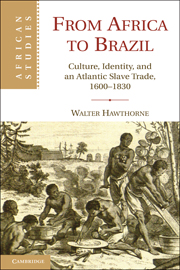Book contents
- Frontmatter
- Contents
- List of Figures
- List of Maps
- List of Tables
- Abbreviations Used in Notes
- Acknowledgments
- Introduction
- PART I THE WHY AND HOW OF ENSLAVEMENT AND TRANSPORTATION
- PART II CULTURAL CHANGE AND CONTINUITY
- 4 Labor over “Brown” Rice
- 5 Violence, Sex, and the Family
- 6 Spiritual Beliefs
- Conclusion
- Index
- References
4 - Labor over “Brown” Rice
Published online by Cambridge University Press: 05 September 2012
- Frontmatter
- Contents
- List of Figures
- List of Maps
- List of Tables
- Abbreviations Used in Notes
- Acknowledgments
- Introduction
- PART I THE WHY AND HOW OF ENSLAVEMENT AND TRANSPORTATION
- PART II CULTURAL CHANGE AND CONTINUITY
- 4 Labor over “Brown” Rice
- 5 Violence, Sex, and the Family
- 6 Spiritual Beliefs
- Conclusion
- Index
- References
Summary
In 1805 in Maranhão, João Diogo de Souza owned a thirty-two-year-old slave named Rita. At the time, the principal crop in the region was rice, so much of Rita’s time was devoted to it. Born on Africa’s Upper Guinea coast in a Balanta village and under a different name, Rita labored for Souza beside twenty-seven other slaves, most of whom (75 percent) were also Upper Guinean by birth. Those with whom Rita had daily contact were Bijago, Mandinka, and Papel, along with four other Balanta. Of Souza’s African-born slaves, only three were from outside Upper Guinea. There were also several Maranhão-born slaves, or crioulos, most of whom were the products of relationships among the Upper Guineans owned by Souza. One of the crioulos was Rita’s one-year-old daughter, Veridina.
We don’t know at what age Rita was made captive, but chances are she was in her teens or twenties when she was enslaved and taken across the ocean. If so, her life on the Upper Guinea coast was patterned like the lives of many other Upper Guinean females. Rita grew up in her father’s household, and she spent much of her infancy carried on her mother’s and sisters’ backs, going everywhere they went. The females in her life spent most of their time working over rice, the staple of area diets. Like most aspects of Balanta society, rice work was gendered; females were charged with planting, weeding, milling, winnowing, cooking, and preparing the cereal as the base for a protein-rich sauce that accompanied every meal. As Rita grew, she continued to spend most of her time with females in her community, learning what it meant to be a successful woman – learning, that is, how to grow rice and prepare it for consumption.
- Type
- Chapter
- Information
- From Africa to BrazilCulture, Identity, and an Atlantic Slave Trade, 1600–1830, pp. 137 - 172Publisher: Cambridge University PressPrint publication year: 2010



